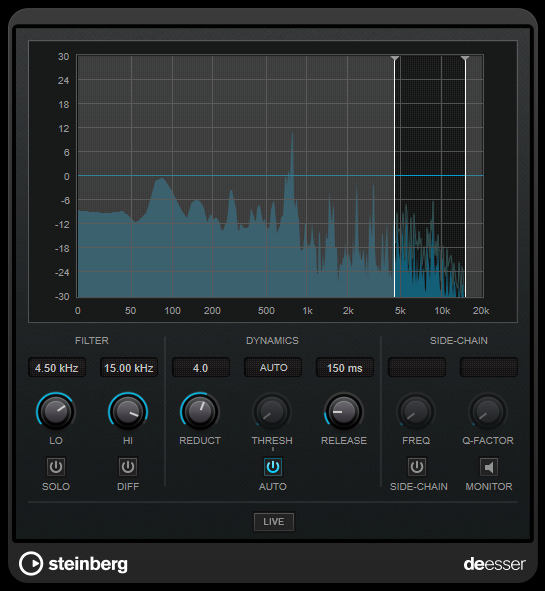DeEsser
DeEsser is a special type of compressor that reduces excessive sibilance, primarily for vocal recordings.

You can use it, for example, when close proximity microphone placement and equalizing lead to situations where the overall sound is just right, but where unwanted sibilants occur.
When recording a voice, the position of DeEsser in the signal chain is usually after the microphone pre-amp and before a compressor/limiter. This keeps the compressor/limiter from unnecessarily limiting the overall signal dynamics.
Display
Shows the spectrum of the input signal.
-
To adjust the frequency band, drag the border lines or click in the middle of the band and drag.
-
To change the width of the frequency band, hold Shift and drag to the left or right.
Filter
- Lo/Hi
-
Sets the left and right border of the frequency band. You can set the frequency either in Hz or as a note value. If you enter a note value, the frequency is automatically displayed in Hz accordingly. For example, a note value of A3 sets the frequency to 440 Hz. When you enter a note value, you can also enter a cent offset. For example, enter A5 -23 or C4 +49.
NoteMake sure that you enter a space between the note and the cent offset. Only in this case, the cent offsets are taken into account.
- Solo
-
Solos the frequency band. This helps you to find the appropriate position and width of that band.
- Diff
-
Plays back what DeEsser removed from the signal. This helps you to adjust the frequency band, threshold, and reduction parameters, so that only sharp s-sounds are removed, for example.
Dynamics
- Reduction
-
Controls the intensity of the de-essing effect.
- Threshold (-50 to 0 dB)
-
If the Auto option is deactivated, you can use this control to set a threshold for the incoming signal level above which the plug-in starts to reduce the sibilants.
- Release (1 to 1000 ms)
-
Sets the time after which the de-essing effect returns to zero when the signal drops below the threshold.
- Auto
-
Automatically and continually sets an optimum threshold setting independent of the input signal. The Auto option does not work for low-level signals (< -30 db peak level). To reduce the sibilants in such a file, set the threshold manually.
Side-Chain
- Side-Chain
-
Activates the internal side-chain filter. You can now shape the input signal according to the filter parameters. Internal side-chaining can be useful for tailoring how the gate operates.
- Freq (25 Hz to 20 kHz)
-
If Side-Chain is activated, this sets the frequency of the filter. You can set the frequency either in Hz or as a note value. If you enter a note value, the frequency is automatically displayed in Hz accordingly. For example, a note value of A3 sets the frequency to 440 Hz. When you enter a note value, you can also enter a cent offset. For example, enter A5 -23 or C4 +49.
NoteMake sure that you enter a space between the note and the cent offset. Only in this case, the cent offsets are taken into account.
- Q-Factor
-
If Side-Chain is activated, this sets the resonance or width of the filter.
- Monitor
-
Allows you to monitor the filtered signal.
- Live
-
If this button is activated, the look-ahead feature of the effect is deactivated. Look-ahead produces more accurate processing, but adds a specific amount of latency as a trade-off. If Live mode is activated, there is no latency, which is better for live processing.
This plug-in supports external side-chaining. For a description of how to set up side-chain routing, see the Operation Manual.
Positioning the DeEsser in the Signal Chain
When recording a voice, the position of DeEsser in the signal chain is usually located after the microphone pre-amp and before a compressor/limiter. This keeps the compressor/limiter from unnecessarily limiting the overall signal dynamics.